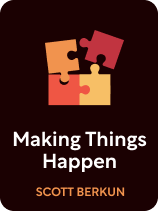

This article is an excerpt from the Shortform book guide to "Making Things Happen" by Scott Berkun. Shortform has the world's best summaries and analyses of books you should be reading.
Like this article? Sign up for a free trial here.
What is a vision document in project management? What are the key qualities of strong vision documents?
According to Scott Berkun’s book Making Things Happen, creating a vision document is an important part of the planning phase for any project. In the book, Berkun offers some tips to help you make a motivational vision document for your project.
Read on to learn what a project vision document is and how to make one, according to Berkun.
Vision Documents for Projects
According to management expert Scott Berkun, a vision document is what wraps up the planning phase of a project. A vision document is a written description of a project’s main goals and objectives (vision), and any other information found during initial planning, such as customer research.
Qualities of a Strong Vision Document
According to Berkun, there are a few key qualities this document should have. Most importantly, the main vision set forth in the document should be easy to understand. When a vision is clear on the project’s goals, people can easily refer to it at any time to help them answer questions or make decisions. A vision should also be motivational, so that the team understands how their work contributes to the overall goals of the project. Finally, the document should integrate many ideas into a coherent whole. A manager should include all helpful information in the document but do so in a way that remains focused and digestible.
Gathering Information for Your Document
According to Berkun, a requirement is any condition that needs to be met for the project to be considered finished. Project requirements help determine what the team is trying to accomplish or what problem the project is going to solve, which will be helpful to include in your vision document. They should be simple, so designers have room for interpretation and can brainstorm different ways to solve the problem.
(Shortform note: The author of The Clean Coder points out that leaving room for interpretation of a requirement, as Berkun recommends, can present its own problems. Sometimes a client’s request can be too vague, resulting in the wrong product or program being built. The ambiguity of requirements should be addressed not by being more precise, but by regularly testing to see if what is being built is what the customer or client desires.)
To provide an example, a client requesting a new-build house gives the requirement that it have three bedrooms. The person designing the house knows they need a structure with at least three bedrooms, but there are plenty of options to choose from there. They may ask the customer how many square feet they want, how many bathrooms, what type of architectural style, or any other clarifying questions.
Berkun provides one simple method to develop good requirements: problem statements. These are brief descriptions of problems that come from research or customer feedback. For example, a consumer may complain that there are no cheap, reliable electric vehicles on the market. Providing such a vehicle could be the main requirement of an entire project.
Problem statements can also provide requirements for smaller problems or features. A customer may complain that an app doesn’t have a proper search tool, which could then be a requirement for the next software update.
(Shortform note: The author of SPIN Selling recommends using a similar strategy to help sell a product or service. Instead of generating problem statements, however, the focus is on asking problem questions. Problem questions are meant to reveal a customer’s desires or needs, and they could be an effective way to generate problem statements. For instance, you could ask a competitor’s customer what they don’t like about the product and use it to build a product that addresses their problem.)
Why a Strong Vision Is Important
Berkun claims that vision documents are the most important part of the planning process, as they provide value throughout the project when done correctly. Because of this, a project manager should devote more effort to the document than any other part of planning.
A vision document provides the team with the overarching goal of the project, and it allows anyone on the team to review the initial decisions the team made. It’s invaluable to have a written document to refer to instead of relying on the collective memory of the team. For instance, the documents may remind you why you made certain scheduling decisions or why you chose not to include a particular feature as a requirement.
Additionally, the bigger and more complex a project is, the more a vision document will help: If a project has hundreds of people working on it, the document provides a common reference point for everyone if disagreements, confusions, or other problems occur.
| Staying True to Your Vision In The Making of a Manager, Julie Zhuo argues that sharing a powerful vision is one of the most important tasks of a manager, but she calls the articulation of this a vision statement, not a vision document. And while the definitions each overlap significantly, Zhuo adds that a strong vision statement should be specific, in addition to motivational, easy to understand, and integrated. Beyond writing it, Zhuo recommends two things a manager can do to ensure the project stays true to its statement and keeps employees inspired and on-task: Connect every project action to the vision statement: Every single task and short-term assignment should have a clear link to the project’s overall goals. This further helps keep the vision statement fresh in employees’ minds, as Berkun recommends. Reinforce the vision statement as often as possible: A manager should insert the vision into one-on-one conversations, in emails, and in larger meetings. This constant reminder will ensure the project keeps in line with its overall mission, especially when your project and team are large. |

———End of Preview———
Like what you just read? Read the rest of the world's best book summary and analysis of Scott Berkun's "Making Things Happen" at Shortform.
Here's what you'll find in our full Making Things Happen summary:
- Answers to the questions you have about leadership and project management
- What managers can do at each phase of a project to ensure its success
- Why schedules are unreliable yet useful






